
Many farmers make fish ponds at random. Sometimes it is not even more like a puddle of water. This is what makes cultivation productivity is not maximal.
Pool factor is not less important with other cultivation factors such as seeds, feed and water. Fish pond is a place of live fish habitat. Fish pond conditions determine whether or not the growth of fish.
There are several things to consider in making fish ponds. Starting from analyzing soil type, land contour, pond layout, irrigation, excavation, embankment making until water circulation arrangement.
Analyze soil types

The best type of soil to make a pond is sandy clay. This type of soil is quite waterproof, the texture is solid so that the making of the dike is easier.
if the available soil is too loose, it needs extra effort to function properly. For example the pool walls are lined with cement or bricks. This method effectively prevents leakage, but the cost of construction is much more expensive.
The simple way to determine the type of soil is to grasp a clump of soil that has been soaked in water. Then ground the soil firmly. Then open your palm. If on the surface of the palm of the hand there is little sand then it can be said sandy clay. When the amount of sand attached in the palm of the hand a lot, the land is categorized loose soil.
Contour of land
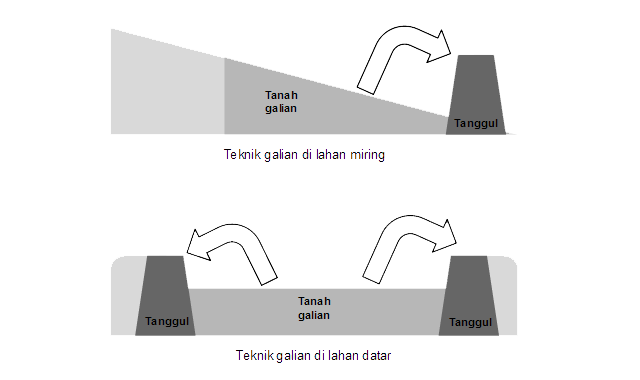
After analyzing the soil type, observe the contour of the land that will be used as a fish pond. Whether the land is flat or sloping land. The slope of the land determines the method of excavation and embankment construction. On sloping land, the arrangement of water flow patterns is easier.
Excavation of soil on slopes is done on one side. Then the minerals used to make the embankment on the other side. While on flat land, excavation is done on all sides. Excavation results are used to create embankments. For more details, see the picture below.
Fish pond layout
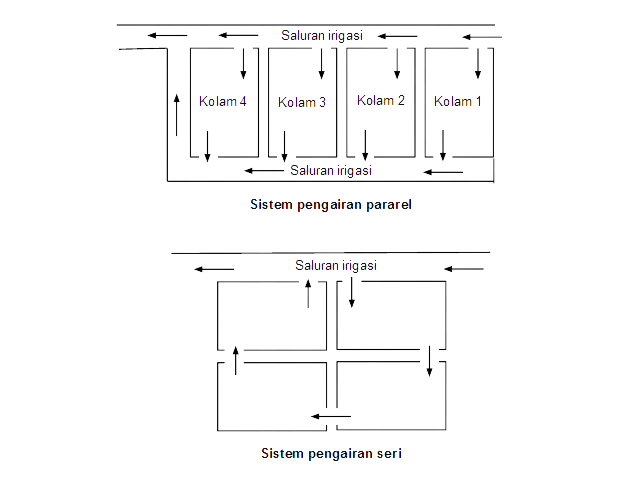
If we want to make one pool only, the layout of the pool is simpler. Stay maximize the location of the ditch used as a source of water and exhaust system. But if the number of ponds that will be made a lot. The layout of the pond needs to be carefully considered.
Viewed from the irrigation system there are two types of fish pond layout, namely parallel and series. In parallel watering systems each pool receives water intake from the water source directly. The ditch or irrigation canal must be made through each fish pond.
Consequently construction costs will be greater.
Parallel watering systems are better in terms of maintaining water quality. Because the water into the pond is fresh water, directly from the water source. Not contaminated by the remnants of dissolved feed or disease seeds that exist in previous fish ponds.
While in a series watering system, each fishpond receives water intake from other pool expenditures. For example, the first fish pond gets water from a water source directly. Then the second fish pond receives the water intake from the first pool expenditure.
The third fish pond receives water intake from the expenditure of the second fish pond, and so on.
The series irrigation system is suitable to be applied in areas with limited water resources.
The weakness of the series irrigation system is that it is difficult to control water pollution and the spread of disease. For example if the first pool of disease, will easily spread to the next pool. So also with other water contaminants.
The advantages of the irrigation channel series system are unlikely to take place and can be made simple. So the cost of construction is cheaper. Maintenance costs are also cheaper.
Create a water channel
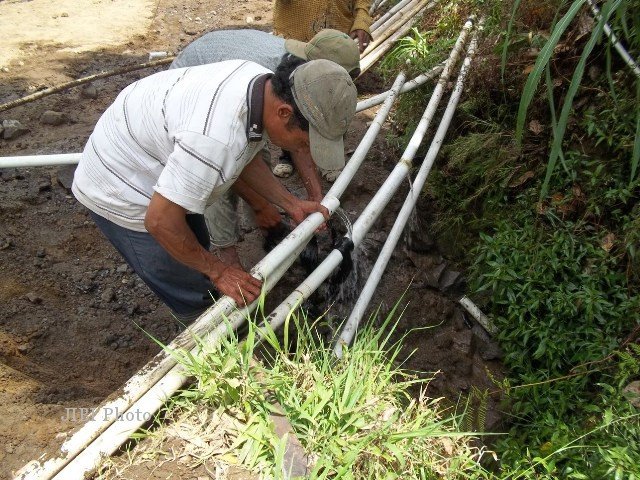
Inlet and outlet channels are a vital part of fish ponds. This channel is responsible for maintaining the quality of pond water. When the water channel is blocked, the quality of pond water will drop and can cause death in fish.
Incoming and outgoing water channels for fish ponds can be made more than one. In large pools, usually made 2-3 pairs of water channels. In smaller ponds enough to make a pair of channels.
The distance between incoming and outgoing channels should be made as far as possible. The location of incoming and outgoing channels as far as possible crossed do not align. Useful for water circulation in the pool. The incoming water does not come out immediately, but replaces the old water.
a. Incoming channel
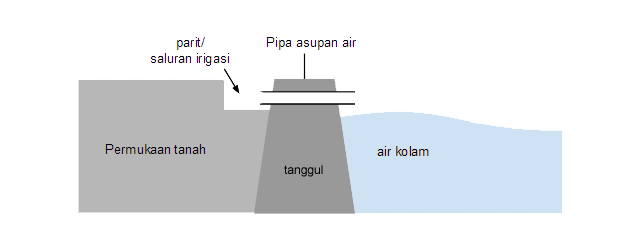
Incoming channels can be made with bamboo sheath or PVC pipe. Pipe placed cut and penetrated the embankment. The height of the pipe is parallel to or higher than the desired surface of the pond water.
The pipe is installed horizontally, at the base leading to the outside of the pond fitted with a net so that no animal can get in and out of the pond. Here's the picture.
b. Outlet
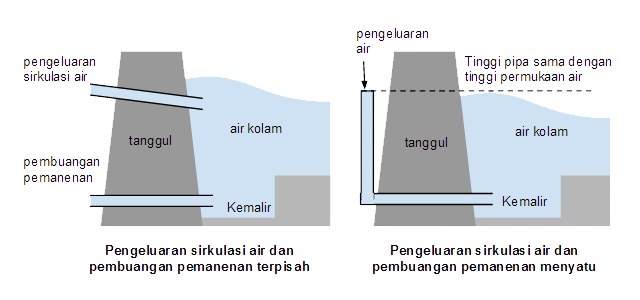
There are two kinds of outlets for fish ponds, namely the outlet of the pond water as the circulatory system and the pond water outflow for harvesting. Techniques of making both channels can be put together or apart.
The first technique separately. Circulating water discharge pipes are made on the surface of the pond and harvesting pipes are made at the bottom of the pond. Pipes made on the surface, mounted transversely on the embankment. The portion facing the pond is lower than the part outside the pool.
The expenditure pipes for harvesting are made at the bottom of the lowest pond. Usually made on the channels of kemalir. At the end of the pipe that is in the pond fitted with a valve that can be opened and closed.
The second technique is unified. Water and harvesting pipes are made one. To make it required a "L" shaped pipe, or pipe menyiku. This pipe is made at the bottom of the pond. The pipe leading out of the pool forms the letter L looking up.
High vertical standing pipe parallel to the surface of the pond water. With this technique the water level of the pond is easier to manage.
Makes kemalir
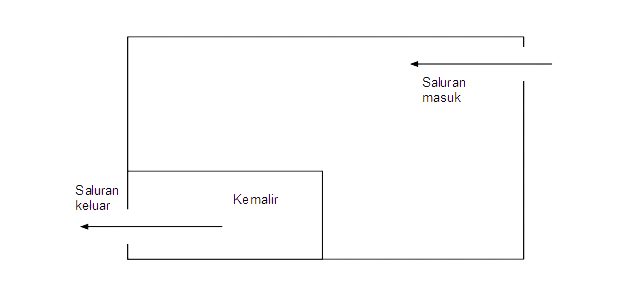
The drainage channel is an important part of the fish pond. Kemalir is a trench that is at the bottom of the pond, its depth is about 20-30 cm. Kemalir works to assist harvesting, collecting food deposits, depositing dangerous sludge and regulating the flow of water down. The number of kemalir adjusted with the door of water discharge.
Using irrelevant tags, especially popular tags, makes it hard to find good and relevant content.
Please try to use only relevant tags when posting!
#homesteadingchallenge
Please be mindful of challenge-specific tags. These tags are for articles written exactly according to the rules of the specific challenge.
This week's homesteadingchallenge theme is "bucket list".
Blatant misuse of tags is spam. Spam is discouraged by the community and may result in action from the cheetah bot.
Hello, you used the #homesteadslackers tag, but we cannot find you listed on our SteemitHomesteaders.Slack.com membership list. What is your slack username in the community so we can accurately link you?
If you're not a member, we'd love to have you join our community! Check out this link: https://steemit.com/community/@steemithomestead/join-the-steemithomesteaders-slack-community
Information on the creation and rules for use of the #homesteadslackers tag can be read about here: https://steemit.com/homesteadslackers/@steemithomestead/homesteadslackers
Thanks!
@steemithomestead
Why is the information on your images in a different language compared to your writing. Is this a google translated article?
Where are your references?
Interesting article @kachful however this does not meet the requirements for the current #homesteadingchallenge. Please remove the tag and use it if you write an article that fits the current criteria. Thank you